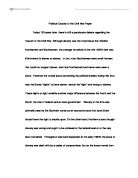Adya Roy
2nd period
1st rough draft
The “Undercover” Impact on the Civil War
Have you ever wondered what happens “undercover”? Has it ever occurred how much it can affect the outcome of something? The patriotism spies felt for America is commendable. According to Spying in the Civil War, ladies involved in the Civil War made the best spies. They made their debut in American espionage. This was the only time Americans approved or appreciated a woman doing a man’s job. Although men were commendable too, men could not bring themselves to hurt or shoot at a lady. For these reasons, ladies could pass in and out of enemy lines with ease. (¶7). Men weren’t lagging much behind, though (Civil War Spies, ¶ 4-8). If you think about it, men probably weren’t as recognized as women because men were recognized in almost every field.
Spies had to be perfect at their guises and tactics for their success. According to Peggy Caravantes, Albert A. Nofi and Bryna Stevens, Sarah Emma Edmonds was the best at her guises. In her childhood, Edmonds often had to help her father with chores regularly done by boys, and she built a strong, lean body. Later, her body and her guises, helped her disguises as Franklin Thompson, “Cuff” (a plantation slave), a peddler, a widow and a Kentuckian confederate soldier (also named Frank Thompson). Due to these guises, Edmonds could pass through enemy lines again and again, successfully. A few times, her guises were that close to perfection that she was mistaken for the character she was disguised as. (p. 12,19,23-25. p.31-32. p. 59-62) . I think Sarah’s success is mainly due to her guises, for she would’ve definitely been caught when dressed up as Frank or Cuff. According to Civil War Spies, Kellogg Brown was disguised as a Union deserter on the ship Charm, on his first mission. Because he was supposed to be a Union deserter, the confederates treated him like their own. Through this comradeship, he was able to obtain loads of statistical information about their ships, and sizes of troops. . (¶ 4) George Curtis was disguised as a contraband merchant, selling ammunition, for his first mission. That was his means of making his way to Richmond for the actual mission. Also, he got a pass to go through enemy lines from General Hill, so he could provide ammunition for the other side. General Hill often asked favors from Curtis, like delivering dispatches to General Macgruder. Had he known that all the dispatches were reaching Mr. Bangs (Pinkerton’s man) first, and then reaching General Macgruder, he might have changed his mind. Due to his perfection at guises, Curtis was never caught, arrested or suspected for involvement in Espionage activities. (¶ 5)







